 |
||
|
||
| ||
The progress of the IT industry is an interesting and sometimes unpredictable thing. Year after year, it speeds up, advances with seven-league strides, sweeping away all obstacles no matter how solid they could seem. The famous "Taiwanese quartet" (Asustek, ECS, Gigabyte, MSI) can serve as a perfect example. Not long ago, hardly anybody could imagine that these motherboard manufacturers would expand their scope of activity to a truly galactic extent. Today the quartet produces almost everything that an average IT consumer could possibly need: mainboards, ODDs, cases, various computer accessories, monitors, notebooks, advanced barebones, and even network equipment. And interestingly, their achievements are taken for granted. Indeed, there are no virgin IT-lands left that wouldn't have been explored by these Taiwanese giants. And PC cooling systems are no exception: their fertile soils are intensively cultivated by all the members of the quartet. Asustek was the main conquistador here. It was the first of the companies to fix its eyes on cooling systems, which resulted in the appearance of several coler models for Socket A and Socket 478. By the way, this line of Asustek's activity is still alive now, which can be proved by the volley of new ASUS coolers at the latest CeBIT. Then ECS and MSI followed Asustek's example and since that time, the companies (together with their business partners) have been creating cooling devices for desknotes and barebones. And finally, this spring Gigabyte joined in, announcing a whole series of high-end multiplatform coolers. We couldn't disregard them, and today we'll tell you about their "middle-sector element", the PCU21-VG model (market name 3D Cooler-Pro). A closer lookHowever high-flown it may sound, PCU21-VG refers to the small class of cooling systems that catch your eyes immediately. It has a lot to look and to wonder at: an innovative heatsink made of four 6-mm copper heatpipes and a section of 43 0.4-mm alluminium heat-dissipating fins, as well as a massive 80x60-mm centrifugal fan. 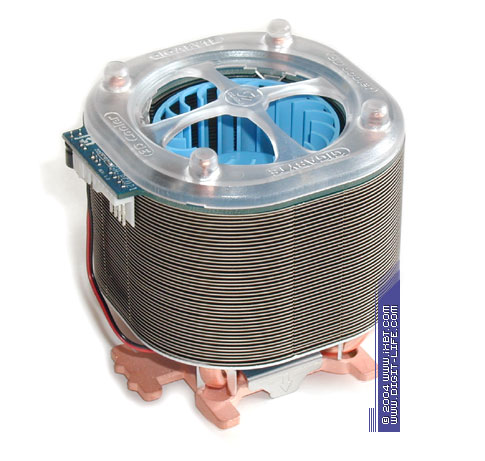
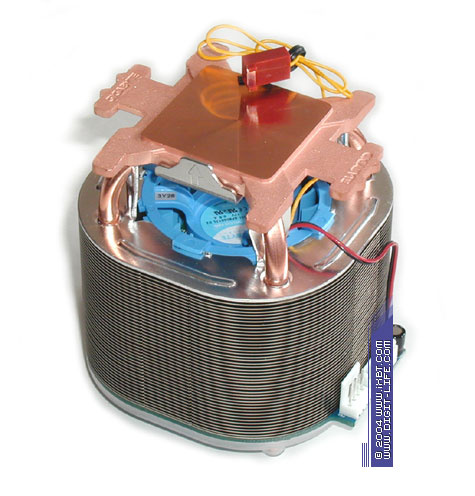 A high-end product, PCU21-VG follows almost all fashion trends. The cooler is compatible with actual PC platforms (Socket 478, Socket A, Socket 754/940), is supplied with an advanced linear regulation scheme of impeller rotation (2000 to 4800 RPM), and is fitted with a lively LED illumination.  The complete package also contains a multiplatform fastening set, fan power adapter, an external regulator/potentiometer (made on an alluminium fin that is installed into the 3.5" bay on the front side of the case), an additional fin for potentiometer mounting (installed into the back panel), thermal grease, and a manual (including Russian). Not bad for the start. But what if we dig a little deeper? Will there be anything special and remarkable about the new Gigabyte product? Key features and practical examinationThe main "place of interest" in PCU21-VG is certainly a curious combination of heatpipes and a centrifugal fan. Generally speaking, both parts have been long used in PC cooling systems, but it's the first time they are combined in a storm-in-the-teacup way. The centrifugal fan plays the responsible role of the storm, and the teacup is represented by the section of fins fixed on the heat-emitting surface of the pipes. The fact that the technology combines an attractive novelty (which doesn't always mean effectiveness) and a technological advantage, makes it all the more interesting. The technology enables to eliminate two interrelated drawbacks at a time: huge dimensions and a low heat efficiency — drawbacks typical of standard heatpipe-based configurations. The traditional approach implies taking a number of heatpipes, fitting them with broad rectangular fins, and covering it all with a protection shell. Axial fans are installed at one or both ends of the resulted cube. The approach has a serious disadvantage, namely, there's no effective blasting of the cube. The axial fan usually generates rather weak static pressure of the air flow, and if heat-dissipating fins are set close to each other (the step is at less than 1 mm), the fan can't cope with a huge hydraulic resistance of such cube. There are only two ways to raise efficiency. You can either increase the step between the fins (and thus, make the system much bigger), or you can install hugely powerful fans (and to enjoy the noise they produce). Due to its superior technology, PCU21-VG can avoid these problems. The cooler has a centrifugal fan that is characterised by a very high nominal static pressure and is therefore times more effective than traditional axial fans. The "teacup" along the fan's perimeter is made of a section of small pins (the walls are about 15 mm thick), but at the same time, it has an impressive heat-dissipation area, about 2500 sq cm. It is a "teacup" that even a very weak centrifugal fan can blast. As a result, PCU21-VG features a perspective cooling duet of a centrifugal fan and heatpipies. 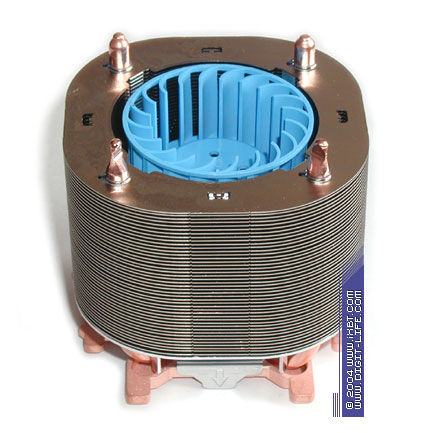 Meanwhile, reality spoils this blissful picture with a small but tricky thing. A more thorough analysis of the cooler shows that the fins are fixed to the pipes with an ordinary thermal glue. It has a bad impact on the quality of the pipes-fins thermal contact and leads to an increase in full thermal resistance of the cooler. It seems absolutely obvious that soldering or any other advanced means of thermomechanical contact would be much better. Another interesting thing about PCU21-VG is that it's a truly multiplatform cooler. It is hardly a secret that compatibility with all actual platforms declared by a cooler's manufacturer often remains such only on paper. I must confess, I expected a similar thing of PCU21-VG, but surprisingly, the cooler is equally easy to install onto almost any motherboard, be it Socket 478, Socket A, or Socket 754. This fact is due to a well thought-over heatsink base that meets AMD and Intel norms, and a multiplatform fastening set (all three fastening variants require no screwdrivers, just a press-down effort). The only shortcoming is the cooler's above-norm weight (about 440 g). But this deviation is not crucial — if you don't throw the PSU to the floor from a meter-high point, the cooler will be dead tight in the socket.  PCU21-VG construction has one more interesting detail: a separate board that houses LEDs and the fan power regulator. This solution seems to be really sound — it is not very good to litter the fan's small control chip with additional electronics. And if you want to make your fan more functional, do it wisely — use a separate board. 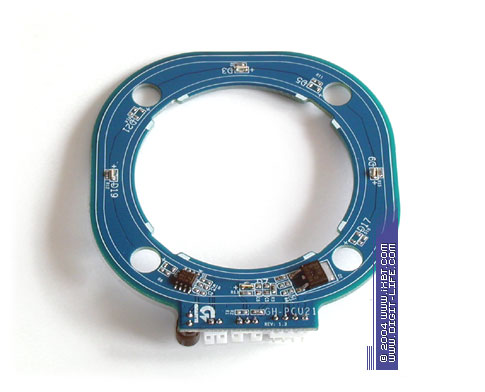 We would also like to note a good quality of the onboard fan itself (Bi-Sonic BP806012L) that features a solid mechanical basis (two frictionless bearings), a sound two-phase inductor, and a neat control chip. 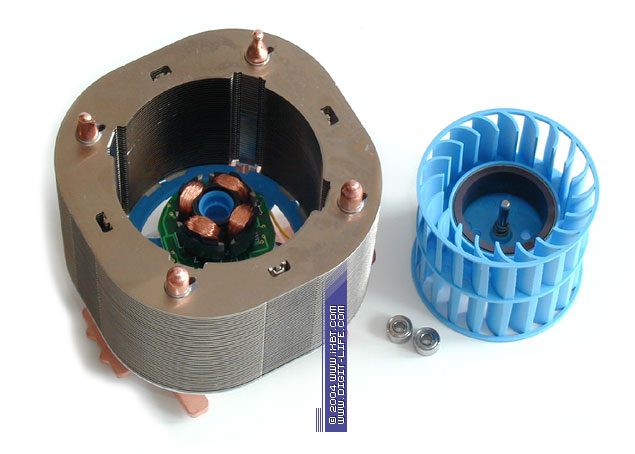 But how does PCU21-VG fulfil its primary task to cool down hot modern CPUs? We can answer that in general, the cooler does it well. But its performance, however, still leaves much to be desired and doesn't correspond to the potential that should have been realised by all means. When it works at maximal frequencies (4800 RPM), PCU21-VG demonstrates a quite good heat efficiency, getting very close to such monster as Zalman CNPS7000A-Cu. But that comes at a too high price: the noise is way too high above the tolerable level. Nobody in his right mind can stand it for a long time, and even if he does, he is likely to have problems with his deafened neighbours :). The middle mode (3400 RPM) produces far less noise, but the cooler's effectiveness falls too. To the extent that it loses not only to "monsters", but also to advanced economy-class coolers. And finally, the slowest mode (2000 RPM) makes PCU21-VG really quiet, but then again, the cooler can't show decent heat efficiency and slides down right to the budget class. However, such non-exemplary performance was to be expected: a low-quality thermal contact between the heatpipes and the heat-dissipating fins has left its imprint. And while maximal frequencies could make up for it (at the expense of terrible noise), normal modes clearly revealed the cooler's imperfection. Well, Gigabyte experts have a lot to think about. The only thing left for us to examine is the test results. After it, we'll draw our conclusions. Test resultsWe will begin with heat efficiency results. Configuration of testbed 1:
Configuration of testbed 2:
To model a close-to-the-maximal heat load, we used the burnk7 utility from CPUBurn (Socket A platform) and burnp6 (two exemplaries, Socket 478 platform). The temperatures were controlled by Motherboard Monitor (Socket A platform) and System Guard made by Fijitsu Siemens Computers (Socket 478 platform). And here are the test results:
Diagram 1. Temperature readings (Socket A platform)
Notes Diagram 2. Temperature readings (Socket 478 platform)
Notes Diagram 3. Thermal resistance (Socket A platform)
Diagram 4. Thermal resistance (Socket 478 platform)
And finally, here are the results of noise measurements (the method is described in Coolers' noise characteristics and noise measuring methods).
Diagram 5. Niose characteristics (coolers for Socket A)
Evidently, no more comments are needed. It's time we dotted the i's. ConclusionsThe Gigabyte PCU21-VG cooler has left us with mixed feelings. On one hand, it brings innovative ideas and has a very good potential as it offers to customers a curious symbiosis of heatpipes and a centrifugal fan. On the other hand, technical realisation of these ideas has some negative aspects (not optimal thermal contact, high noise level in turbo modes) which prevent PCU21-VG from becoming a really functional cooler. Anyway, our congratulations to Gigabyte upon its debut in cooling systems! Hopefully, the company's experts will do their best to improve its products, and Gigabyte will make customers happy with great-looking and highly-functional cooling systems. There is a lot of room for experiments, so good luck!
05.05.2004
Write a comment below. No registration needed!
|
Platform · Video · Multimedia · Mobile · Other || About us & Privacy policy · Twitter · Facebook Copyright © Byrds Research & Publishing, Ltd., 1997–2011. All rights reserved. |